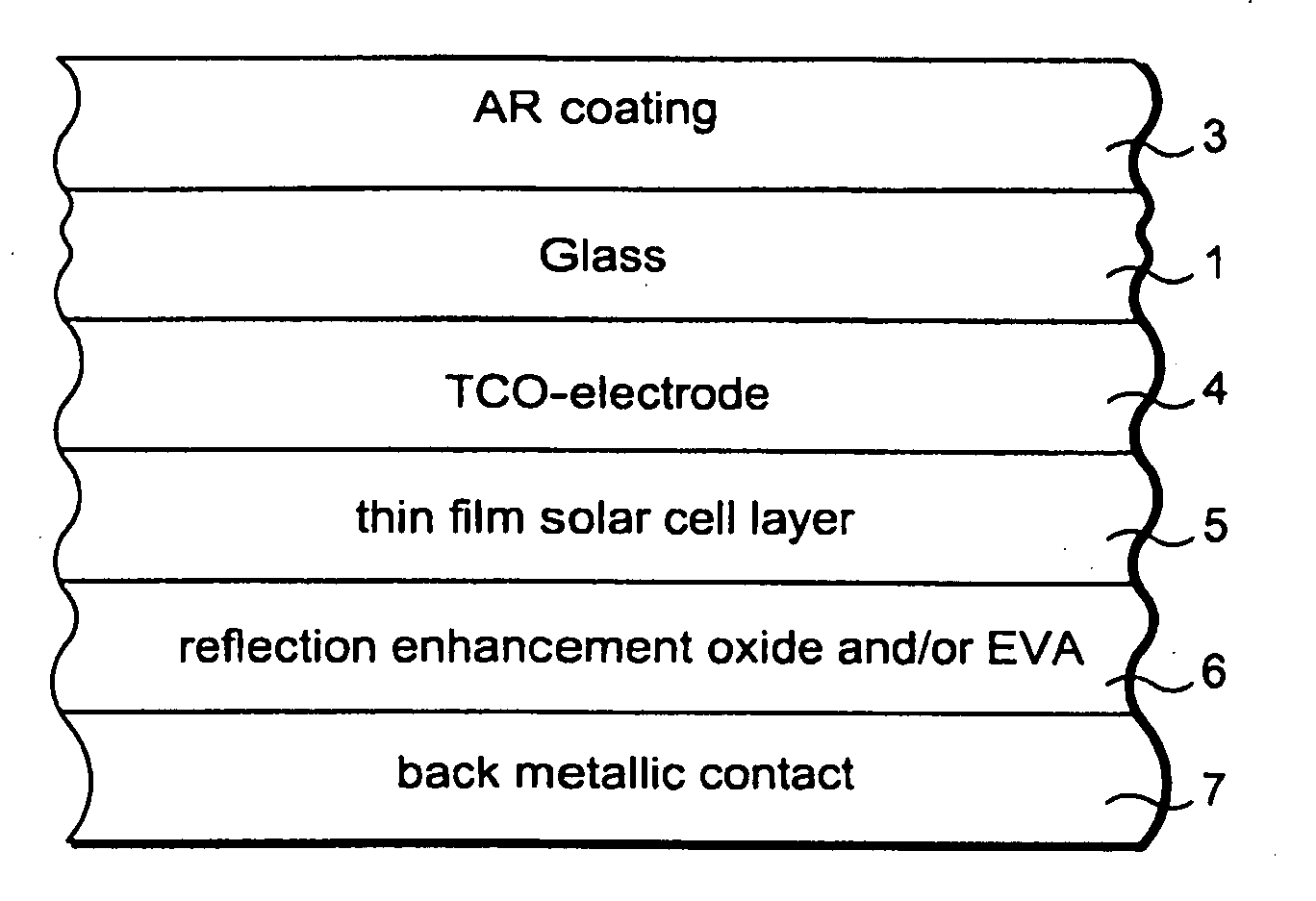Method of making an antireflective silica coating, resulting product, and photovoltaic device comprising same
a technology of porous silica and anti-reflective coating, which is applied in the direction of anti-reflective coating, instruments, transportation and packaging, etc., can solve the problems of environmental durability of ar coatings derived from porous silica, degradation of surface quality, and inability to meet the requirements of environmental durability, etc., to achieve the effect of improving durability
- Summary
- Abstract
- Description
- Claims
- Application Information
AI Technical Summary
Benefits of technology
Problems solved by technology
Method used
Image
Examples
example # 1
Example #1
[0047]The silica sol was prepared as follows. A polymeric component of silica was prepared by using 64% wt of n-propanol (available from Chem Central), 24% wt of glycycloxylpropyltrimethoxysilane (glymo) (available from Gelest, Inc.), 7% wt of water and 5% wt of hydrochloric acid (available from VWR International). These ingredients were used and mixed for 24 hrs. The coating solution was prepared by using 21% wt of polymeric solution, 7% wt colloidal silica in methyl ethyl ketone supplied by Nissan Chemicals Inc, and 72% wt n-propanol. This was stirred for 2 hrs to give silica sol. The final solution is referred to as a silica sol. The silica coating was fabricated using the spin coating method with 1000 rpm for 18 secs. The coating was heat treated in furnace at 625° C. for three and a half minutes. This coating does not have any barrier layer. The environmental durability of the coating was done under following conditions for high humidity and freezing.[0048]Ramp—Heat f...
example # 2
Example #2
[0055]In Example #2, a bottom layer was made as mentioned in Example #1 and then followed the heat treatment. After cooling down to room temperature, a primer layer based on isopropyl alcohol and isobutyl alcohol (commercially available as SP-22 from Exxene Corporation) was applied on the AR coating by flow method. The coating was dried at 120° C. for 5 minutes. The coating was cooled down to room temperature. Then antifog coating based on modified siloxane in organic solvent (diacetone alcohol) (commercially available Exxene HCAF-424 antifog solution) was fabricated using flow coating method. The coating was dried at 125° C. for 5 minutes. The coatings were subjected to the environmental testing as illustrated in the Example #1. Transmission was measured before and after the environmental testing and result shown in Table 2. The change in % T after testing is 3.65.
example # 3
Example #3
[0056]Example #3 is same as Example #2 except the antifog coatings are based on a hydrofluoroether (FogTech supplied by MotoSolutions, CA). The antifog coating was applied by flow coating method and dried at room temperature. The coatings were subjected to the environmental testing as illustrated in the Example #1. Transmission was measured before and after the environmental testing and result is shown in Table 2. The change in % T after testing is 0.45.
PUM
| Property | Measurement | Unit |
|---|---|---|
| temperature | aaaaa | aaaaa |
| thickness | aaaaa | aaaaa |
| temperature | aaaaa | aaaaa |
Abstract
Description
Claims
Application Information
 Login to View More
Login to View More - R&D
- Intellectual Property
- Life Sciences
- Materials
- Tech Scout
- Unparalleled Data Quality
- Higher Quality Content
- 60% Fewer Hallucinations
Browse by: Latest US Patents, China's latest patents, Technical Efficacy Thesaurus, Application Domain, Technology Topic, Popular Technical Reports.
© 2025 PatSnap. All rights reserved.Legal|Privacy policy|Modern Slavery Act Transparency Statement|Sitemap|About US| Contact US: help@patsnap.com


